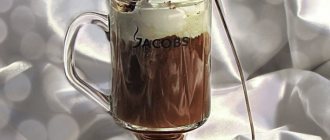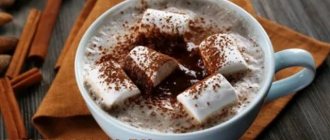Coffee and cognac are a classic pairing. According to connoisseurs, good French brandy should be drunk either neat or according to the three C rule: with dark chocolate, aromatic cigar or strong coffee. Even the ambassador of the famous cognac house Courvoisier insists on this: “The French have been drinking cognac with coffee since the end of the 18th century. This is our tradition." However, to truly enjoy this combination, cognac, like coffee, must be of high quality: the cognac must be mature, and the coffee must be freshly ground and freshly brewed.
Traditionally, coffee and cognac are served separately - coffee in a small coffee cup, and cognac in a special snifter glass at room temperature.
Based on these drinks, many different cocktails are also made: warming and cooling.
Coffee with cognac and Amaretto
This recipe is ideal at any time of the year. To prepare it you will need freshly brewed coffee, cognac, almond liqueur and caramel syrup.
Ingredients
- 160 ml whipped cream
- 30 ml Amaretto liqueur
- 30 ml cognac
- Freshly brewed coffee
- Caramel syrup or sauce
Preparation
Pour coffee into a tall highball glass about 3/4 full. Add cognac and liqueur. To stir thoroughly. Garnish with fresh cream. Drizzle caramel syrup on top. Serve with a cocktail straw.
Ice coffee and cognac
This simple cocktail is more suitable for hot summers. Invigorating and refreshing at the same time, it will be a real find for those with a sweet tooth.
Ingredients
- 180 ml freshly brewed chilled coffee
- 45 ml cognac
- 1 tablespoon sugar syrup
- Whipped cream
- Ice
Preparation
Mix coffee, sugar syrup and cognac in a chilled glass. Add ice and whipped cream. Serve with a cocktail straw.
Coffee with cognac and cardamom
This recipe was proposed by the famous Martha Stewart. The cocktail she invented is in many ways similar to Irish coffee, but instead of whiskey, French cognac is used.
Ingredients
- 160 ml water
- 85 g sugar
- 6 cardamom pods
- 160 ml cognac
- 500 ml freshly brewed coffee
- Whipped cream
Preparation
Heat water with cardamom over medium heat. Dissolve sugar in it. Add hot coffee and cognac. To stir thoroughly. Pour into four glasses. Garnish with whipped cream.
Coffee as a national drink
Residents of the country consider coffee not only a national product, but also a part of culture and history. Almost every family owns at least a small piece of land on which they grow a coffee tree. And each one keeps its own family recipe for making an invigorating drink, which is passed down from generation to generation.
Yemenis have certain rituals and traditions associated with coffee, so they treat this drink with great respect. If a Yemeni family offers you coffee, you should never refuse it. After all, such an invitation is a sign of great respect and refusing it means an insult to the inviter.
Before drinking coffee, Yemenis thoroughly wash their hands and rinse their mouths to fully enjoy the taste of this wonderful drink.
To make Yemeni coffee, the coated beans are roasted on a baking sheet and then ground in a mortar. The resulting powder is boiled in a Turkish coffee pot (ibrik), bringing to a boil 2 times in a row. The drink turns out strong and thick.
Salt, ginger, cloves, butter and other additives are added to the finished coffee. The bitter and strong Kahwa Murrah (murrah) is cooked quite rarely and used as a snack with dates. Even avid coffee lovers who have tried many exotic coffee drinks will find its taste incomprehensible and unusual.
For those who want to try making Yemeni coffee at home, the recipe can be slightly adapted. You will need:
- 1-2 tsp. ground coffee;
- 1-2 tsp. Sahara;
- a little ginger root (1 cm);
- 120 ml cold water.
Peel and chop the ginger. Place everything in a Turk and brew Turkish coffee. Strain. The resulting drink will have a strong coffee-ginger aroma. Its richness can be reduced by using a little less ginger.
In the south of the country, in the Yafi mountainous area, coffee of the same name is most often prepared. "Yafi" consists of wheat grains (three parts), coffee beans (five parts), clover and African durra (forage and grain plant). All this is thoroughly crushed and then boiled in milk with added sugar. Sometimes cloves, ginger or nutmeg are added for flavor.
In addition, Yemenis love sweet Mazbout with 1 tsp added per cup. sugar and no less sweet Helo with two teaspoons.
But the most delicious coffee drink in Yemen is gishr or geshir. It is prepared from dried berry pulp (without grains). It tastes nothing like coffee, but rather resembles a dried fruit compote. With all this, there is much more caffeine in it than in the classic drink.
For the traditional recipe, 1/5 of the teapot's volume of dried coffee berries is taken from the husks, which are filled with cold water and brought to a boil over low heat. The drink must be brewed for at least 10 minutes. Honey, sugar, cardamom, cinnamon, cloves or ginger are added to the finished gyshr.
Coffee with whiskey
In different countries of the world, coffee is mixed not only with cognac, but also with other strong drinks. For example, Irish and highland coffee are very popular in Scotland and Ireland. In it, instead of cognac, 30 ml of whiskey - Irish or Scottish, as well as 50 ml of cream and sugar to taste are added to the coffee. The ingredients are mixed in a glass: first pour whiskey and add sugar, stir thoroughly, and only then add coffee and cream.
A similar recipe with bourbon is called American coffee. Its peculiarity is the pleasant aroma of caramel and vanilla, which is inherent in many varieties of American whiskey. If desired, you can also add honey liqueur or a drop of natural honey to the cocktail.
The benefits and harms of the drink
Discussions and debates on this matter continue, but no definite answer is given, because there are both disadvantages and advantages.
Beneficial effects:
- helps hypotensive patients normalize blood pressure;
- increases performance, increases concentration;
- restores strength;
- is an antidepressant.
Let's talk separately about cognac, which:
- strengthens the immune system;
The healing properties of this type of alcohol appear during the technological process:
- biologically active alcohols and essential oils are released, which give the alcoholic drink anti-inflammatory and antimicrobial qualities.
- helps prevent vascular pathology - atherosclerosis, which leads to heart attack, partial or complete disability, as well as irreversible consequences;
- has a beneficial effect on veins, normalizes blood microcirculation;
According to studies, people with type 2 diabetes can drink coffee and cognac in consultation with their doctor. The reason is that alcohol reduces glucose levels - the absorption of sugar from the body is activated, the properties of the blood are stabilized.
- Since cognac contains copper, diseases of the joints and thyroid gland are prevented, iron is better absorbed and the number of red blood cells increases, which fill tissues and organs with oxygen.
Questionable positive effects include help with the first cold symptoms and headaches. In the first, it is rare that the drink has a beneficial effect, in the second, it is more likely that it is low blood pressure.
There are benefits from the cocktail in the right proportions. The main thing is how much cognac to add to coffee, drink it infrequently and objectively assess your own health status.
Negative effects:
- dangerous for people with cardiovascular diseases;
At the same time, two mutually exclusive processes occur: alcohol reduces blood pressure, relaxes the walls of blood vessels, and caffeine does the opposite - there is a risk of developing arrhythmia, tachycardia and other serious consequences;
- serious stress for hypertensive patients;
- negative effect on the brain and central nervous system - failure of coordination, memory, etc., digestive tract, teeth when taking the drink separately;
- bone tissue suffers, vulnerability to fractures increases, osteoporosis develops;
- the condition of hair, nails, and tooth enamel deteriorates due to the leaching of calcium and essential microelements from the body;
- dehydration and first symptoms: deterioration, weakness, fatigue;
- the likelihood of private colds increases;
- sleep is disturbed if used incorrectly.
Each person evaluates the benefits and harms of coffee with cognac for himself, but remember:
- An alcoholic cocktail can be consumed in moderation.
- The drink cannot be used as a therapeutic method and with the intention of continuing the day behind the wheel of a car.
- One cup a day 3-4 times a week.
- Follow the proportions for the selected coffee and cognac recipe.
- If you feel unwell or experience strange symptoms after drinking your favorite drink, seek medical advice.
Coffee Corretto
A cocktail of coffee and strong alcohol in Italy is called Caffe Corretto - proper coffee. Most often, sweet and aromatic grape grappa is added to it, which perfectly complements the bitter taste of traditional espresso. This combination is so popular among Italians that you can order Corretto coffee in almost any coffee shop. The recipe is very simple: a small amount of grappa is poured into black, undiluted coffee without sugar, and served in ordinary coffee cups.
It is noteworthy that in Venice they add not grappa to espresso, but amaretto and sambuca - this is how the famous Venetian coffee is prepared. To add a special aroma, vanilla syrup or liqueur is also added to the cocktail, and everything is decorated with whipped cream. If desired, sambuca can be replaced with cognac.
History and features of production
It is not known for certain, but Arab sources indicate that coffee trees were grown in Yemen as early as 1100. The export of fertile coffee beans was prohibited. Thanks to this, this Arab country became the first exporter of coffee beans. But she failed to maintain the monopoly.
Enterprising traders around the world quickly realized the benefits of its production and sale, and began to develop extensive coffee plantations. At the end of the 17th century, Yemen completely lost its leadership position in the world coffee market and today is among the fifth ten exporting countries.
The development of this Arab country, including the growth of cities, a decrease in land suitable for agriculture, water supply problems, as well as great competition among producing countries, led to the fact that in the 20th century no more than 11 thousand tons of coffee were grown in Yemen in year. Of this amount, more than 30% is consumed in the domestic market.
But despite all this, Yemeni coffee is still valued all over the world for its exquisite taste and unsurpassed aroma. After all, this is the only country that produces 100% environmentally friendly Arabica beans. The process of growing coffee trees here is still the same and occurs without the use of fertilizer chemicals or pesticides .
Yemeni coffee is harvested in the fall and only by hand. After harvesting for 3-4 days, the grains are dried and aired on large dishes that are placed on the roofs of houses. Then the raw materials are put into a dark room so that the beans “absorb the sun”, and after a while they are sent back to the sun’s rays.
They peel the dried coffee berries with millstones, and then on a large dish the women begin tossing the raw materials so that the husks collect at the edge, which makes it easier and faster to remove all the debris. Clean grains are distributed into baskets. The only innovation in fruit processing for more than 500 years is the emergence of greenhouses where coffee sprouts are grown before they are transplanted.
The plantations themselves are also noteworthy. Coffee trees in Yemen grow at an altitude of 1000-2000 meters at equal distances from each other on steep mountain slopes in the shade of fruit trees, protecting them from sunlight and strong winds.
Coffee in Russian
One of the strongest, most delicious and unusual coffee-based cocktails is Russian coffee. To prepare it you will need 30 ml of vodka, 15 ml of Kahlua liqueur, 1 tablespoon of amaretto, 150 ml of black coffee, whipped cream, cocktail cherries and sugar. All ingredients are mixed in a large coffee cup, after which the cocktail is decorated with cream and a cherry.
Of the strong cocktails with coffee, it is worth mentioning the most unusual one - with absinthe. This unusual combination was created for those who are not afraid to experiment. 30 ml of absinthe is mixed with the same amount of tangerine or orange vodka and cream, as well as 90 ml of hot coffee. Served in a coffee cup with whipped cream and cinnamon.
Who is prohibited from drinking the drink?
Despite the small dose of alcohol and barely perceptible odor, there are contraindications for a cocktail with cognac:
- children, including adolescence - up to 18 years, pregnant and lactating women, elderly people;
- constant high blood pressure, because surges in the functioning of blood vessels and the heart aggravate the well-being of hypertensive patients;
- excessive excitability or depression;
- the presence of cardiac and vascular pathologies, mental disorders;
- diseases of the gastrointestinal tract - ulcers, gastritis;
- during the period of taking medications, the instructions of which indicate a ban on drinking coffee or cognac.
What to do: to drink or not to drink cognac with coffee
If you are in good health and know how to control yourself, then a rare cup of such an alcoholic cocktail will only bring benefits and lift your spirits.
For those who feel a weakness for alcohol, try to limit yourself, do not create a habit with negative consequences for well-being, career and family.
Choose a coffee recipe with cognac to make coffee at home. And don’t forget that health is your main resource.











